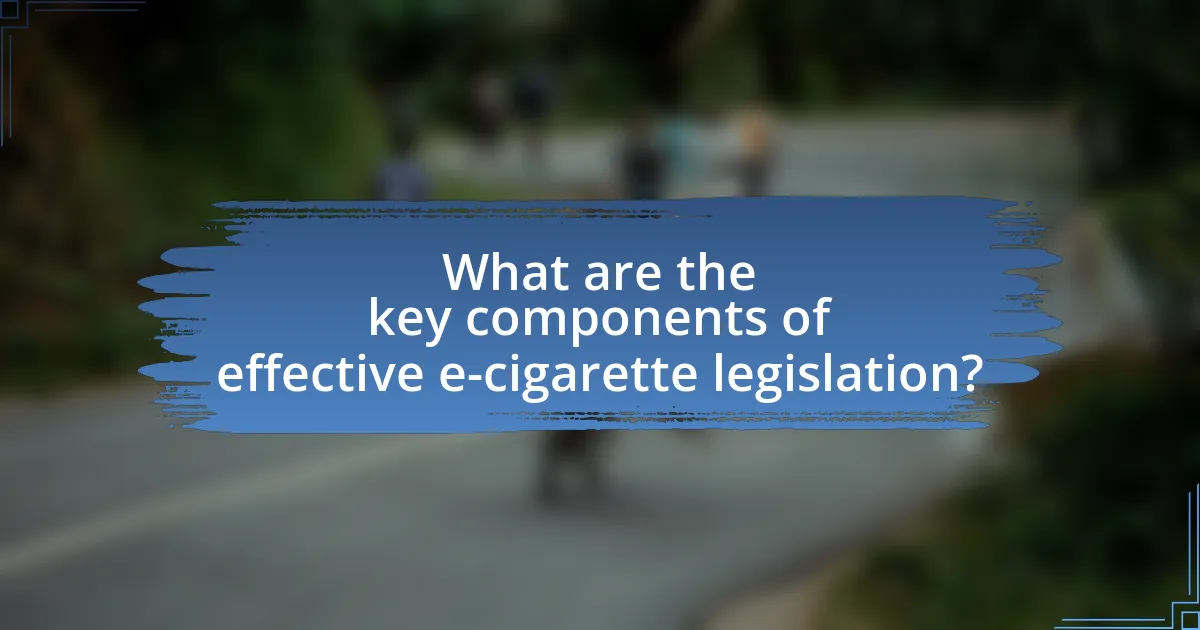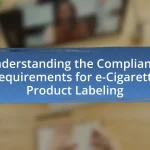Public health organizations, such as the American Public Health Association and the World Health Organization, play a vital role in shaping e-cigarette legislation through research, advocacy, and collaboration with government entities. They provide evidence-based recommendations to policymakers, highlighting the health risks associated with e-cigarette use, particularly among youth, and advocating for regulations like age restrictions and marketing limitations. The article explores the strategies these organizations employ, the challenges they face from the tobacco industry, and the importance of effective legislation in mitigating health risks. Additionally, it discusses how public perceptions and emerging research influence legislative efforts, as well as best practices for enhancing community engagement and advocacy in the context of e-cigarette regulation.

What is the Role of Public Health Organizations in Shaping e-Cigarette Legislation?
Public health organizations play a crucial role in shaping e-cigarette legislation by providing research-based evidence and advocacy for regulatory measures. These organizations, such as the American Public Health Association and the World Health Organization, conduct studies that highlight the health risks associated with e-cigarette use, influencing policymakers to consider stricter regulations. For instance, the CDC reported that e-cigarette use among youth has increased significantly, prompting public health organizations to advocate for age restrictions and marketing regulations to protect minors. Their efforts often include lobbying for comprehensive tobacco control policies that encompass e-cigarettes, thereby ensuring that legislation reflects public health priorities and scientific findings.
How do public health organizations influence e-cigarette policies?
Public health organizations influence e-cigarette policies by conducting research, advocating for regulations, and providing evidence-based recommendations to policymakers. These organizations, such as the Centers for Disease Control and Prevention (CDC) and the World Health Organization (WHO), utilize data on the health impacts of e-cigarettes to inform legislation. For instance, the CDC reported that e-cigarette use among youth has increased significantly, prompting calls for stricter regulations on sales and marketing practices. Additionally, public health organizations often collaborate with community groups to mobilize public support for policy changes, thereby enhancing the effectiveness of their advocacy efforts.
What strategies do these organizations employ to advocate for legislation?
Public health organizations employ strategies such as grassroots mobilization, coalition building, and evidence-based advocacy to advocate for legislation. Grassroots mobilization involves engaging community members to raise awareness and influence policymakers through organized campaigns. Coalition building brings together various stakeholders, including health professionals and advocacy groups, to present a united front and amplify their message. Evidence-based advocacy relies on research and data to support legislative proposals, demonstrating the public health impact of e-cigarettes and the need for regulation. For instance, studies have shown that comprehensive tobacco control policies can significantly reduce smoking rates, which these organizations use to bolster their legislative efforts.
How do public health organizations collaborate with government entities?
Public health organizations collaborate with government entities through partnerships that focus on research, policy development, and public health initiatives. These collaborations often involve sharing data and resources to inform legislation, such as regulations on e-cigarettes, ensuring that policies are evidence-based and effective. For instance, the Centers for Disease Control and Prevention (CDC) works with state health departments to monitor tobacco use trends and provide guidance on e-cigarette regulations, which helps shape comprehensive public health strategies. This synergy enhances the capacity of both public health organizations and government entities to address health issues effectively.
Why is e-cigarette legislation important for public health?
E-cigarette legislation is important for public health because it regulates the sale and use of vaping products, thereby reducing the risk of nicotine addiction and exposure to harmful substances. Research indicates that e-cigarettes can contain toxic chemicals, and legislation helps to establish safety standards and age restrictions, which are crucial for protecting youth. For instance, the Centers for Disease Control and Prevention (CDC) reported that e-cigarette use among high school students increased from 1.5% in 2011 to 27.5% in 2019, highlighting the urgent need for regulatory measures to curb this trend and safeguard public health.
What health risks are associated with e-cigarette use?
E-cigarette use is associated with several health risks, including respiratory issues, cardiovascular problems, and potential addiction to nicotine. Research indicates that e-cigarettes can lead to lung inflammation and damage, as evidenced by studies showing increased rates of respiratory symptoms among users. Additionally, the American Heart Association has reported that e-cigarette use may increase the risk of heart disease due to the presence of harmful chemicals like formaldehyde and acrolein. Furthermore, nicotine addiction can occur, particularly among youth, as highlighted by the National Institute on Drug Abuse, which notes that e-cigarettes are a significant source of nicotine exposure for adolescents.
How can legislation mitigate these health risks?
Legislation can mitigate health risks associated with e-cigarettes by implementing strict regulations on their marketing, sales, and usage. For instance, laws that restrict advertising to minors and mandate health warnings on packaging can reduce youth exposure and consumption. Additionally, regulations that limit the concentration of harmful substances in e-cigarettes can directly decrease health risks. Evidence from the Centers for Disease Control and Prevention indicates that comprehensive tobacco control policies, including e-cigarette regulations, have led to a decline in smoking rates and associated health issues.
What challenges do public health organizations face in shaping e-cigarette legislation?
Public health organizations face significant challenges in shaping e-cigarette legislation, primarily due to the influence of the tobacco industry and the rapid evolution of vaping technology. The tobacco industry often employs lobbying tactics and funding to sway policymakers, creating a complex environment for public health advocates. Additionally, the lack of comprehensive research on the long-term health effects of e-cigarettes complicates the development of evidence-based regulations. For instance, a study published in the journal Tobacco Control highlights that the evolving nature of e-cigarette products makes it difficult for legislation to keep pace, resulting in regulatory gaps. These factors hinder public health organizations’ ability to implement effective policies aimed at reducing e-cigarette use, particularly among youth.
What opposition do they encounter from the tobacco industry?
Public health organizations encounter significant opposition from the tobacco industry, primarily through lobbying efforts and misinformation campaigns. The tobacco industry actively seeks to undermine regulations proposed by these organizations by promoting the idea that e-cigarettes are a safer alternative to traditional smoking, despite evidence suggesting potential health risks. For instance, the tobacco industry has funded studies that downplay the dangers of nicotine and e-cigarette use, aiming to influence public perception and policy decisions. This resistance complicates the efforts of public health organizations to implement stricter e-cigarette legislation aimed at reducing youth access and promoting cessation.
How do public perceptions of e-cigarettes impact legislative efforts?
Public perceptions of e-cigarettes significantly influence legislative efforts by shaping policymakers’ views and priorities. When the public perceives e-cigarettes as harmful or a public health threat, legislators are more likely to propose and support stricter regulations, such as age restrictions and advertising limitations. For instance, a survey conducted by the American Lung Association found that 70% of respondents believed e-cigarettes should be regulated like tobacco products, prompting legislative bodies to consider similar measures. Conversely, if public perception leans towards viewing e-cigarettes as a safer alternative to smoking, there may be resistance to implementing stringent regulations. This dynamic illustrates how public sentiment directly affects the legislative landscape surrounding e-cigarettes.

What are the key components of effective e-cigarette legislation?
Effective e-cigarette legislation includes age restrictions, product regulation, marketing limitations, and health warnings. Age restrictions prevent minors from accessing e-cigarettes, which is crucial given that studies show early exposure increases the likelihood of nicotine addiction. Product regulation ensures that e-cigarettes meet safety standards and that harmful ingredients are limited, as evidenced by research indicating that unregulated products can contain toxic substances. Marketing limitations, particularly those targeting youth, are essential to reduce the appeal of e-cigarettes to younger demographics, supported by data showing that advertising influences youth smoking behaviors. Lastly, health warnings inform consumers about the risks associated with e-cigarette use, which is vital for public awareness and informed decision-making.
What specific regulations are commonly proposed by public health organizations?
Public health organizations commonly propose regulations such as age restrictions on e-cigarette sales, advertising limitations, and product labeling requirements. These regulations aim to reduce youth access to e-cigarettes, minimize exposure to marketing that targets minors, and ensure consumers are informed about the contents and potential risks of e-cigarette products. For instance, the Centers for Disease Control and Prevention (CDC) and the World Health Organization (WHO) advocate for comprehensive policies that include these measures to protect public health and prevent nicotine addiction among young people.
How do age restrictions play a role in e-cigarette legislation?
Age restrictions are critical in e-cigarette legislation as they aim to prevent underage access to vaping products. These regulations are designed to protect youth from the potential health risks associated with nicotine addiction and other harmful substances found in e-cigarettes. For instance, the U.S. raised the minimum legal age for purchasing tobacco products, including e-cigarettes, to 21 in 2019, reflecting a growing consensus among public health organizations that such measures can reduce youth smoking rates. Studies indicate that states with stricter age restrictions have seen a decline in e-cigarette use among adolescents, supporting the effectiveness of these legislative measures in promoting public health.
What labeling and marketing restrictions are recommended?
Recommended labeling and marketing restrictions for e-cigarettes include clear health warnings, age restrictions, and prohibitions on misleading claims. Public health organizations advocate for labels that prominently display the risks associated with nicotine and other harmful substances, ensuring consumers are informed. Additionally, marketing strategies should avoid targeting youth and should not imply that e-cigarettes are a safe alternative to traditional smoking. These recommendations are supported by studies indicating that clear labeling and responsible marketing can reduce youth uptake and promote informed consumer choices.
How do public health organizations assess the effectiveness of e-cigarette legislation?
Public health organizations assess the effectiveness of e-cigarette legislation through a combination of data analysis, surveys, and monitoring health outcomes. They analyze trends in e-cigarette usage rates among different demographics, particularly youth, to determine if legislation is reducing access and consumption. For instance, studies have shown that regions with stricter regulations often report lower rates of e-cigarette use among adolescents. Additionally, organizations conduct surveys to gather public opinion and behavioral changes post-legislation, which helps gauge compliance and awareness. Monitoring health outcomes, such as changes in respiratory health or nicotine addiction rates, provides further evidence of the legislation’s impact. These methods collectively validate the effectiveness of e-cigarette regulations in promoting public health.
What metrics are used to evaluate public health outcomes?
Metrics used to evaluate public health outcomes include morbidity rates, mortality rates, prevalence and incidence rates of diseases, quality-adjusted life years (QALYs), and health-related quality of life (HRQoL) measures. These metrics provide quantitative data that help assess the effectiveness of health interventions and policies. For instance, morbidity rates indicate the frequency of disease occurrence, while mortality rates reflect the number of deaths in a population, both of which are crucial for understanding public health trends. Additionally, QALYs combine the quality and quantity of life lived, offering a comprehensive view of health outcomes. These metrics are essential for public health organizations to shape effective legislation, such as those related to e-cigarettes, by providing evidence-based insights into population health impacts.
How do organizations gather data on e-cigarette usage trends?
Organizations gather data on e-cigarette usage trends primarily through surveys, research studies, and public health monitoring systems. For instance, the National Youth Tobacco Survey (NYTS) collects data on tobacco product use among youth, including e-cigarettes, providing insights into usage patterns and demographics. Additionally, organizations may analyze sales data from retailers and conduct longitudinal studies to track changes over time. These methods enable public health organizations to assess the impact of e-cigarette legislation and inform policy decisions effectively.

What future trends can be anticipated in e-cigarette legislation?
Future trends in e-cigarette legislation are likely to include stricter regulations on marketing, flavor restrictions, and increased taxation. Public health organizations are advocating for these measures to reduce youth access and consumption of e-cigarettes, as evidenced by the rising rates of vaping among adolescents. For instance, the Centers for Disease Control and Prevention reported that in 2021, 19.6% of high school students used e-cigarettes, prompting calls for more comprehensive regulatory frameworks. Additionally, several states have already implemented flavor bans, reflecting a growing trend towards limiting the appeal of e-cigarettes to younger demographics. These legislative movements are expected to continue as public health concerns remain at the forefront of discussions surrounding vaping products.
How might emerging research influence future legislation?
Emerging research can significantly influence future legislation by providing evidence-based insights that inform policymakers about the health impacts of e-cigarettes. For instance, studies demonstrating the link between e-cigarette use and respiratory issues can lead to stricter regulations on their sale and marketing. Research published in the journal Tobacco Control indicates that increased awareness of the health risks associated with vaping has prompted legislative actions in various jurisdictions, such as age restrictions and flavor bans. This trend illustrates how data-driven findings can shape public health policies and regulatory frameworks surrounding e-cigarettes.
What role does technology play in shaping e-cigarette regulations?
Technology plays a critical role in shaping e-cigarette regulations by enabling the collection and analysis of data on usage patterns, health impacts, and product safety. Advanced technologies, such as data analytics and artificial intelligence, allow public health organizations to monitor trends in e-cigarette consumption and assess the effectiveness of existing regulations. For instance, the Centers for Disease Control and Prevention (CDC) utilizes technology to track vaping-related health issues, which informs policymakers about necessary regulatory adjustments. Furthermore, innovations in product design and manufacturing processes can lead to the development of safer e-cigarette products, prompting regulatory bodies to establish standards that ensure consumer safety.
How can public health organizations adapt to changing trends in vaping?
Public health organizations can adapt to changing trends in vaping by continuously monitoring usage patterns and emerging research to inform their strategies. For instance, they can implement real-time data collection methods, such as surveys and focus groups, to understand demographic shifts and preferences among users. This approach allows organizations to tailor educational campaigns and policy recommendations effectively.
Additionally, public health organizations can collaborate with researchers and academic institutions to analyze the health impacts of new vaping products, ensuring that their guidelines reflect the latest scientific evidence. For example, studies have shown that certain flavorings in e-cigarettes can pose unique health risks, prompting organizations to advocate for regulations that limit these ingredients.
By engaging with stakeholders, including manufacturers, consumers, and policymakers, public health organizations can also influence legislation that addresses the evolving landscape of vaping, ensuring that public health remains a priority in regulatory frameworks.
What best practices can public health organizations adopt for effective advocacy?
Public health organizations can adopt several best practices for effective advocacy, including building coalitions, utilizing data-driven messaging, and engaging in grassroots mobilization. Building coalitions with other organizations enhances credibility and amplifies the advocacy message, as seen in successful campaigns like the Tobacco Control Movement, which united various stakeholders to influence policy. Utilizing data-driven messaging ensures that arguments are backed by credible research, such as the CDC’s findings on the health impacts of e-cigarettes, which can effectively persuade policymakers. Engaging in grassroots mobilization empowers community members to advocate for change, demonstrated by initiatives that have successfully rallied public support for stricter e-cigarette regulations. These practices collectively enhance the effectiveness of advocacy efforts in shaping public health policies.
How can organizations enhance community engagement in legislative efforts?
Organizations can enhance community engagement in legislative efforts by actively involving community members in the decision-making process. This can be achieved through strategies such as hosting public forums, conducting surveys to gather input, and forming coalitions with local stakeholders. For instance, public health organizations that have successfully engaged communities in e-cigarette legislation often report increased public awareness and support for regulatory measures, as seen in the 2019 California Tobacco Control Program, which utilized community feedback to shape local policies. Engaging the community not only fosters a sense of ownership but also ensures that legislative efforts reflect the needs and concerns of the population, ultimately leading to more effective public health outcomes.
What partnerships can strengthen advocacy for e-cigarette legislation?
Collaborations between public health organizations, educational institutions, and community advocacy groups can significantly strengthen advocacy for e-cigarette legislation. Public health organizations can leverage research from educational institutions to provide evidence-based data on the health impacts of e-cigarettes, while community advocacy groups can mobilize grassroots support and raise awareness among the public. For instance, partnerships with universities can facilitate studies that highlight the risks associated with e-cigarette use, thereby informing policymakers. Additionally, coalitions that include healthcare professionals can enhance credibility and influence legislative discussions, as they can present firsthand accounts of the health consequences of e-cigarette usage.


